alinorm 10/33/41 - CODEX Alimentarius
alinorm 10/33/41 - CODEX Alimentarius
alinorm 10/33/41 - CODEX Alimentarius
Create successful ePaper yourself
Turn your PDF publications into a flip-book with our unique Google optimized e-Paper software.
ALINORM <strong>10</strong>/<strong>33</strong>/<strong>41</strong> 755. The Committee further agreed to establish an electronic Working Group led by Germany, working inEnglish, that would prepare a revised version, based on the comments submitted at Step 3, for consideration by theCommittee.PROPOSED DRAFT MAXIMUM LEVELS FOR MELAMINE IN FOOD AND FEED (Agenda Item 5) 856. The Delegation of Canada introduced document CX/CF <strong>10</strong>/4/5. The Delegation explained that the purposeof the document was to provide background information on the sources of melamine in food and feed and topresent proposed draft maximum levels (MLs). It was noted that these MLs applied to melamine resulting fromnon-intentional and unavoidable presence in food or feed from approved uses of melamine and from the use ofsubstances which can give rise to melamine contamination and not the deliberate addition of melamine to food orfeed.57. The Committee considered the recommendations made by the electronic working group, in particular theMLs of 1.0 mg/kg for powdered infant formula and 2.5 mg/kg for foods (other than infant formula) and animalfeed, including the possible lower ML of 0.5 mg/kg for ready-to-consume.58. Many delegations supported both the proposed MLs for powdered infant formula and for foods (other thaninfant formula) and animal feed.59. One delegation, while supporting the level of 2.5 mg/kg for all foods and animal feed, proposed a level of0.5 mg/kg for liquid and powdered infant formula, while another delegation proposed a level of 0.5 mg/kg for notonly infant formula, but also follow-up formula and foods for special dietary uses. A number of delegationsexpressed support for the proposal to set a level of 0.5 mg/kg for liquid infant formula. Other delegationssupported a lower level for liquid formula.60. The Observer from the National Health Federation (NHF) expressed concern with the setting of a maximumlevel for melamine and expressed the view that melamine was not a naturally occurring substance, but that itspresence in food was manmade. The Observer stated that a zero tolerance level would be preferred, but in the casethat a ML was needed, questioned why a level of 1 mg/kg could not apply to all foods when it was practicallypossible to achieve such a level in powdered infant formula.61. The Delegation of the European Union while supporting the ML proposed for powdered infant formula,expressed the view that consideration should be given to 3 exemptions for the maximum level of 2.5 mg/kg forfoods and animal feed where higher levels of melamine could occur due to presence of melamine fromcyromazine application; from migration from food contact materials (e.g. melaware); and presence in certain feedadditives/ingredients. It was stated that in the case of cyromazine application especially in mushrooms, the levelof melamine could be as high as the residue level of cyromazine itself. In the case of feed additives or ingredientssuch as guanidine acetic acid, urea and biuret, it was explained that melamine could be present as an unavoidableimpurity even when applying good manufacturing practices.62. The Committee considered how to deal with the proposed exemptions and agreed to the inclusion ofclarification notes, in particular that:• MLs did not apply to food and feed in cases where it can be proven that levels higher than 2.5 mg/kg wasa consequence of authorised use of cyromazine or migration from food contact materials; and• the ML did not apply to melamine that could be present in the following feed ingredients/ additives:guanidine acetic acid, urea and biuret as a result of their normal production process.63. The Observer of NHF expressed concern with the clarification notes and recommended that the Committeeon Food Labelling develop labelling provisions to ensure disclosure of high melamine levels in foods.64. To a proposal to request JECFA to evaluate mixtures of melamine and melamine analogs, the JECFASecretariat explained that interaction of melamine with its analogs had been addressed in the WHO expertconsultation on melamine (December 2008) and that no additional data was available at present. Therepresentative also reminded the Committee that the incident which triggered the need for the setting of MLs formelamine was due to more than 95% melamine contamination and therefore it was important to set levels formelamine alone.8CX/CF <strong>10</strong>/4/5; CX/CF <strong>10</strong>/4/5-Add.1 (comments of Egypt, EU, Kenya, Libya, Mali, the Philippines, Thailand, CIAAand IDF); CRD <strong>10</strong> (comments of NHF); CRD 11 (comments of Ghana); CRD15-rev (comments of ISDI); CRD 22(comments of Ecuador).
















